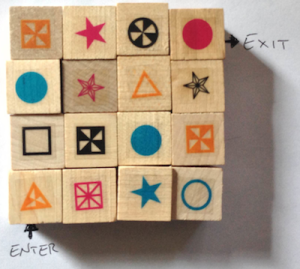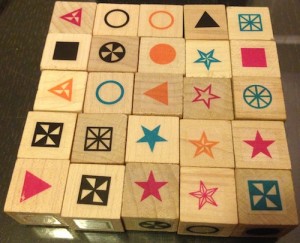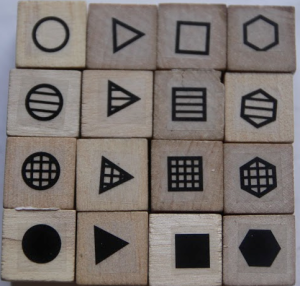Since day 2 or 3 after Block Party’s inception we’ve had the idea to make digital versions of the game. Of course, that will include the classic versions that you can play with the wooden blocks, but it also allows for many other types of gameplay not suited for a physical game. So we got on to thinking, what new games does a digital environment allow with mechanics as with Block Party symbols?
First let’s look at a few ideas which we can borrow generously from. Right now on the short list we have bubble shooter, logic mazes, and the family of {bejewled, dots, and other such games}.
With bubble shooter (you can play a round if you don’t know what it plays like) it seems like it would be easy enough to swap out the simple ‘colors’ for block party symbols where groups are destroyed when they share one value. Because of the hexagonal adjacency, each symbol you add has the potential to form different groups along different attributes (it could have a triangle group on one side and a blue group on another), allowing for much more strategic placement. In a harder variant, we could be eliminating runs of sub-parties, or requiring a full party (either along a single direction, in a group, or something else–though this is likely too difficult to play).

Each 3 in a row in the path must be a sub-party
For logic mazes, I first want to share that block party minis are great for prototyping new games (including digital ones). For an example of a logic maze using block party minis, see the image to the right. The puzzle is to traverse from the bottom left to top right by going along a path where each 3 in a row is a valid sub-party. Conveniently this type of puzzle extends to 3D surfaces, or generally any adjacency matrix (network) where nodes are symbols and edges are potential travel paths.
 jump in rows/cols where each move shares 2 attributes
jump in rows/cols where each move shares 2 attributes
Another variant is instead of walking one block at a time, you must jump within rows and columns so that for any jump you make the symbol you jump two shares two values with the symbol you came from. For an example, try going from the bottom right to the top left of the puzzle on the right.
These maze puzzles at least in my experience have the potential to get quite hard, and I’m pretty sure there’s room for several insights for the solver in a stepped difficulty sequence. Another convenient aspect is that they can be designed purely programmatically, with metrics on the average branching factor used as proxy for human difficulty. Also, they can all start out arbitrarily easy by decreasing the number of attributes or values. Generally, the set can be extended to k attributes each with n values and the exact same mechanics persist (though (3,4) has the nice property of length 3 sub-parties as well as other considerations for human play). One final note I’ll add is that in the world of mazes, mechanics are pretty endless. You can make the maze change over time according to arbitrary rules, you can make it have multiple sides with holes which you switch between, you can have multiple agents which have to accomplish things together (e.g. imagine having 3 players where they all have to move simultaneously and make a sub-party and eventually end up on goal squares). So that’s pretty promising as far as an infinite supply of replayability, though deciding which mechanics result in the most additional insights and sorting by that is the challenge.
And finally a shout out to all those Bejewlers, Candy Crushers, Dots players, and others trapped in tight dopamine loops. Instead of ranting I’ll just ask, what if they were using block party symbols and had more dimensions?



 jump in rows/cols where each move shares 2 attributes
jump in rows/cols where each move shares 2 attributes


